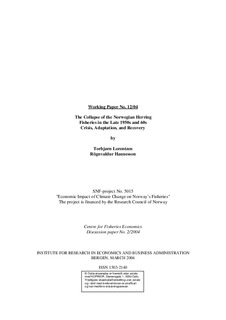The collapse of the Norwegian herring fisheries in the late 1950s and 60s : crisis, adaptation, and recovery
Working paper

Åpne
Permanent lenke
http://hdl.handle.net/11250/166472Utgivelsesdato
2004-03Metadata
Vis full innførselSamlinger
- Working papers (SNF) [809]
Sammendrag
This paper deals with the economic effects of the collapse of the Atlanto-Scandian and the North Sea herring stocks on the Norwegian fisheries. In the late 1950s the Norwegian winter herring fishery failed, and in the 1960s the entire stock of the Atlanto-Scandian herring collapsed. A few years later the North Sea herring stock suffered the same fate. Prior to these events, the herring fishery was the single most important fishery in Norway in terms of employment and landings. It was particularly important in western Norway, not least in the county of Hordaland, on which this paper focuses in particular. The immediate consequence of the collapse of the herring stocks was a severe decline in income and raw material for the processing industry. These difficulties were, however, overcome relatively quickly. The fishing fleet found substitute stocks, such as mackerel and capelin. The government took some measures for immediate employment relief, but over time redundant fishermen were absorbed into other industries, not least the emerging petroleum and fish farming industries. The time of the herring collapse was also a time of transition to a greater specialization in the labour market. Earlier, people had combined fishing with other occupations (farming, carpentry, etc.), but specialization on a single occupation became more and more common. This is likely to have made the adjustment to the herring collapse easier. The demise of the herring stocks in the 1960s and 70s is generally believed to have been the result of overfishing, which in turn was caused by major technological leaps (the power block, the asdic) enabling the fishing fleet to increase its catches by an order of magnitude. At the time there was no framework in place for international fisheries management to limit catches to what the fish stocks could bear. The herring collapses did, however, coincide with a change in ocean climate, so the causal relationship may have been more complicated. The technological changes which contributed to the herring collapse also made it easier to adjust to this event; the bigger and more powerful boats could be directed to fish stocks previously only lightly exploited due to distance and other factors making them less easily accessible.
Utgiver
SNF/Centre for Fisheries EconomicsSerie
Working paper2004:12
Discussion paper
2004:2